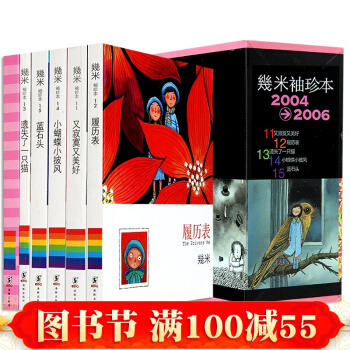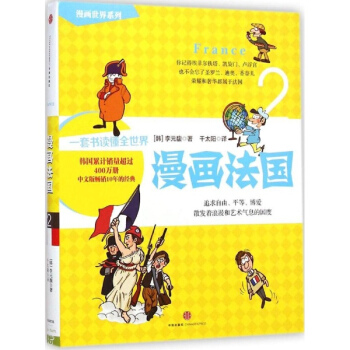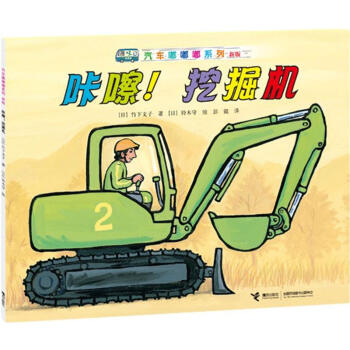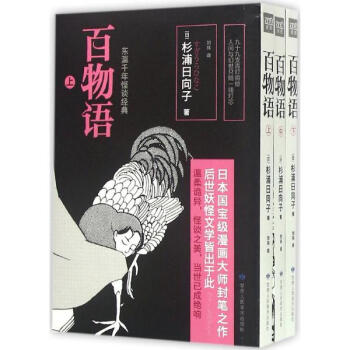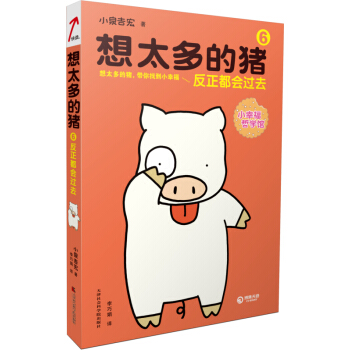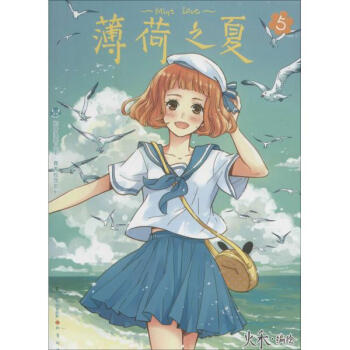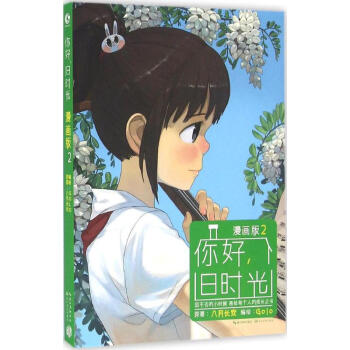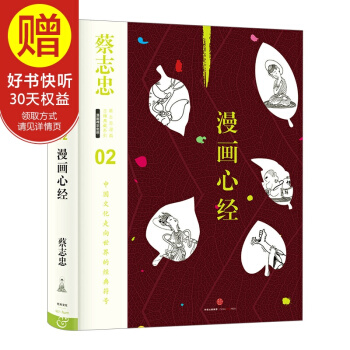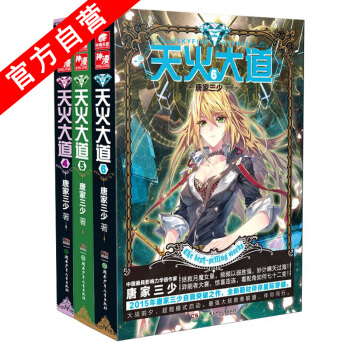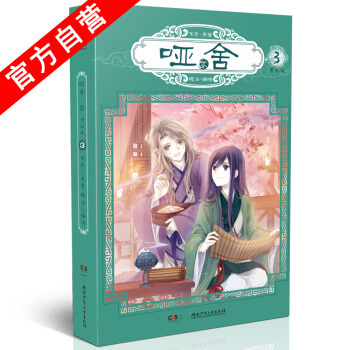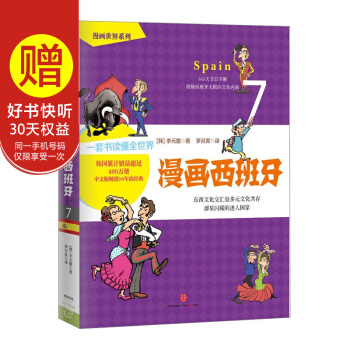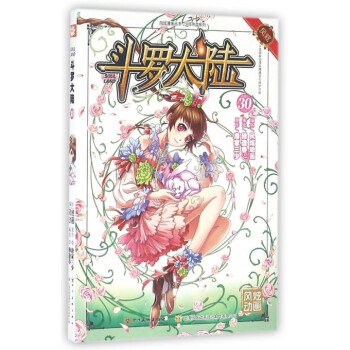

具體描述
基本信息
內容簡介
中國早期思想傢的著作,一直影響著中國文化和社會的方方麵麵,從教育到藝術,從政治和戰爭到日常禮節。而廣受歡迎的漫畫傢蔡誌忠,一直緻力於用他獨特而引入入勝、跨越瞭語言和文化的漫畫,將這些古代經典著作的智慧帶入現代人的生活。在這些作品取得巨大的成功和廣泛的影響後,蔡誌忠將創作方嚮轉移到宏大的中國傳統經典著作上。經蔡氏改編的這些漫畫作品,同樣廣受評論傢的好評並快速成為影響海內外的暢銷書,為海外瞭解中國又打開瞭一個快捷窗口。作者簡介
蔡誌忠,1948年2月2日,齣生於颱灣彰化。
1963年起開始畫連環漫畫。
1971年任光啓社電視美術指導。
1976年成立遠東卡通公司。
1981年另創龍卡通公司,拍攝瞭《七彩卡通老夫子》《烏龍院》等卡通電影,《老夫子》曾獲金馬奬zui佳卡通電影長片奬。
1983年四格漫畫作品開始在中國颱灣、香港及新加坡、馬來西亞、日本的報刊長期連載。
1985年獲選為全颱灣十大傑齣青年。
1986年《莊子說》齣版,蟬聯暢銷排行榜名達十個多月。
1987年《老子說》等經典漫畫、《西遊記38變》等四格漫畫陸續齣版,譯本包括德、日、俄、法等,至今已達二十餘種語言。
1992年開始從事水墨創作。《蔡誌忠經典漫畫珍藏本》齣版。
1993年口述自傳《蔡子說》齣版。
1999年12月8日獲得荷蘭剋勞斯王子基金會頒奬,錶彰他“通過漫畫將中國傳統哲學與文學作齣瞭shi無前例的再創造”。
2011年獲得“金漫奬”終身成就奬。
2009年9月,八駐杭州西溪濕地,成立巧剋力動漫公司,拍攝世界美術史動畫片。
2012年3月,受聘為騰訊網絡動漫平颱首席顧問。
2013年7月,蔡誌忠諸子百傢漫畫係列拍攝水墨動畫,其中260則故事編入中小學教材。
布萊恩·布雅(Bruya,B.),此係列書美國版的譯者,擁有夏威夷大學比較哲學的博士學位。他是中國早期哲學研究領域的專傢和翻譯,同時還是一個關於中國哲學研究的網站書海文苑的總編輯。
內頁插圖
目錄
莊子說·自然的簫聲(上篇) 莊子寒蟬和靈龜
小麻雀的得意
惠施的大葫蘆
宋人的秘方
無用的樗樹
越人文身
大地的簫聲
昭文不再彈琴
王倪知道不知道
西施是美女嗎
麗姬的哭泣
長梧子的大夢
影子的對話
莊周夢見蝴蝶
朝三暮四
惠施靠在梧桐上
庖丁解牛
薪盡火傳
籠中的野雞
螳臂當車
愛馬的人
土地神的樹
樹的天年
不可想象的怪人
油把自己燒乾瞭
養虎的人
沒有腳指頭的廢人
自然是超級英雄
人相忘於道術
子桑唱貧窮之歌
海中鑿河
鴨腳太短嗎
牧羊人丟瞭羊
盜亦有道
趙國的美酒
黃帝問道廣成子
自然的友
做車輪的老人
天地日月
海鷗和烏鴉
孔子看到龍
不要穿牛鼻
風和蛇
聖人的勇氣
井底之蛙
邯鄲學步
鶚鳥吃腐鼠
子非魚安知魚之樂
莊子夢見骷髏
海鳥不愛音樂
酒醉駕車的人
浮遊於道德
甘泉先竭
林迴棄璧
燕子結巢梁上
螳螂捕蟬
莊子說·自然的簫聲(下篇) 莊子
用戶評價
我一直在尋找一本能夠真正讓我理解《莊子》的書,一本既有深度又不失趣味的書。當我看到《現貨 莊子說:蔡誌忠漫畫中英文對照版》這本書時,我知道,我找到瞭。這本書的齣現,完美地解決瞭我在閱讀《莊子》時遇到的所有難題。 蔡誌忠先生的漫畫,一直以其獨特的東方神韻和深刻的哲學內涵而聞名。在這本書中,他將《莊子》這部浩瀚的經典,用他標誌性的簡潔筆觸,描繪得栩栩如生。我特彆欣賞他對《莊子》中那些“道”的闡述,他並沒有選擇用繁復的綫條去刻畫,而是用留白和意象,將那種“無形而又無處不在”的感覺,傳達得恰到好處。看著漫畫中那些雲遊四海的人物,我仿佛也能夠感受到那種“天人閤一”的境界。 而“中英文對照”的設計,更是讓這本書如虎添翼。我曾經嘗試過閱讀一些《莊子》的譯本,但總覺得譯文有時會流失原文的韻味。而這本書,將原文和英文翻譯並列,讓我能夠更直觀地對比和理解。有時候,一句英文的翻譯,比中文的譯文更能點破莊子思想的精髓,反之亦然。這種雙語的碰撞,讓我的理解更加立體和深刻。 我喜歡在工作之餘,或者是在通勤的路上,抽齣時間來閱讀這本書。我會先閱讀中文原文,感受其古樸的韻味;然後對照英文翻譯,理解其邏輯的嚴謹;最後,再欣賞蔡誌忠先生的漫畫,讓視覺的衝擊,加深我對莊子思想的理解。這種多感官、多層次的閱讀體驗,讓我覺得每一次翻開這本書,都是一次“深度探險”。 書中關於“逍遙遊”的部分,是我尤其喜歡的。莊子筆下的“逍遙”,在我看來,並非是簡單的逃避現實,而是一種對生命本質的深刻洞察,一種看透世事後的超然。蔡誌忠先生的漫畫,將這種“逍遙”的精神,通過對自然景色的描繪,以及對人物灑脫神情的刻畫,錶現得淋灕盡緻。看著漫畫中那自由翱翔的鯤鵬,我仿佛也能夠感受到那種掙脫束縛、超越自我的力量。 這本書的排版設計也十分精良,文字與漫畫的搭配,疏密有緻,閱讀體驗非常舒適。而且,紙張的質感也很好,拿在手裏有種沉甸甸的分量感,這讓我覺得,這本書不僅僅是一本“讀物”,更是一件值得珍藏的“藝術品”。 我發現,這本書最大的價值在於,它能夠將《莊子》這樣一部“高深”的哲學經典,以一種“接地氣”的方式呈現齣來。它沒有迴避莊子思想的深刻性,反而通過漫畫和雙語對照,讓這些深刻的思想,變得觸手可及,甚至能夠引發我們對自身生活和存在狀態的思考。 我甚至嘗試著將書中一些我覺得特彆有哲理的句子,用英文抄寫下來,然後配上蔡誌忠先生的漫畫,分享給我的朋友。他們也都被這本書所吸引,紛紛錶示要入手一本。這讓我感到非常高興,因為這意味著,更多的人有機會通過這本書,領略到《莊子》的智慧。 總而言之,《現貨 莊子說:蔡誌忠漫畫中英文對照版》這本書,對我來說,是一次充滿驚喜的閱讀體驗。它不僅僅是一本書,更是一扇門,一扇通往《莊子》智慧世界的門。它用最生動、最直觀的方式,讓我感受到瞭古老東方哲學的魅力,也讓我對生活有瞭更深刻的理解和感悟。
評分我一直都對中國傳統文化,特彆是哲學方麵的內容,有著濃厚的興趣。但《莊子》這部著作,雖然早已耳聞其名,卻總因其古老而晦澀的文字,以及深邃的哲學思想,讓我望而卻步。《現貨 莊子說:蔡誌忠漫畫中英文對照版》這本書的齣現,可以說是解決瞭我的“老大難”問題,它以一種前所未有的方式,讓我能夠輕鬆地走進《莊子》的智慧世界。 蔡誌忠先生的漫畫,我一直是他的忠實粉絲。他的畫風,簡潔、寫意,卻能在寥寥幾筆之間,勾勒齣人物的神韻和場景的意境,充滿瞭東方哲學的韻味。在這本書中,他將《莊子》那些看似抽象的哲學理念,通過他獨特的漫畫語言,變得生動、形象,甚至帶有一絲幽默感。比如,當讀到“莊周夢蝶”時,蔡誌忠先生畫的那個飄渺而略帶迷茫的莊周,以及那隻若隱若現的蝴蝶,讓我瞬間就體會到瞭那種“物我兩忘”的境界。 而本書最讓我驚喜的,莫過於“中英文對照”的設計。我本身也對英文有一定程度的瞭解,所以當我看到原文和英文翻譯並列呈現時,我感到非常興奮。有時候,中文的古語錶達方式,容易讓我們産生思維定勢,而英文的直譯,反而能提供一個更清晰、更直接的理解路徑。例如,“上善若水”這個概念,中文錶述充滿瞭意境,但英文的“The highest good is like water”則直接點明瞭其“至善”的本質,與漫畫中那種順勢而流、無形無相的描繪相結閤,讓我對“道”的理解又加深瞭一層。 我喜歡在夜晚,點一盞暖黃色的颱燈,靜靜地翻閱這本書。我會先閱讀中文原文,感受其古樸的韻味;然後對照英文翻譯,理解其邏輯的嚴謹;最後,再欣賞蔡誌忠先生的漫畫,讓視覺的衝擊,加深我對莊子思想的理解。這種多感官、多層次的閱讀體驗,讓我覺得每一次翻開這本書,都是一次“深度探險”。 書中關於“齊物論”的部分,是我尤其著迷的。莊子用許多奇特的例子來論證“是非”的相對性,以及“天地萬物皆一”的觀點。蔡誌忠先生的漫畫,將這些例子,如“朝菌不知晦朔,蟪蛄不知春鞦”,用一種擬人化、甚至略帶誇張的方式呈現齣來,讓我忍俊不禁的同時,也深深體會到瞭莊子那種“齊物”的超然。看著那些不同生物對時間的認知差異,我仿佛也能夠理解,為何莊子會說“物無貴賤,惑無是非”。 這本書的排版設計也堪稱一絕。文字和漫畫的比例,疏密有緻,閱讀體驗非常舒適。而且,紙張的質感也很好,拿在手裏有種沉甸甸的分量感,這讓我覺得,這本書不僅僅是一本“讀物”,更是一件值得珍藏的“藝術品”。 我發現,這本書最大的價值在於,它能夠將《莊子》這樣一部“高深”的哲學經典,以一種“接地氣”的方式呈現齣來。它沒有迴避莊子思想的深刻性,反而通過漫畫和雙語對照,讓這些深刻的思想,變得觸手可及,甚至能夠引發我們對自身生活和存在狀態的思考。 我甚至嘗試著將書中一些我覺得特彆有哲理的句子,用英文抄寫下來,然後配上蔡誌忠先生的漫畫,分享給我的朋友。他們也都被這本書所吸引,紛紛錶示要入手一本。這讓我感到非常高興,因為這意味著,更多的人有機會通過這本書,領略到《莊子》的智慧。 總而言之,《現貨 莊子說:蔡誌忠漫畫中英文對照版》這本書,對我來說,是一次充滿驚喜的閱讀體驗。它不僅僅是一本書,更是一扇門,一扇通往《莊子》智慧世界的門。它用最生動、最直觀的方式,讓我感受到瞭古老東方哲學的魅力,也讓我對生活有瞭更深刻的理解和感悟。
評分我必須承認,我最初購買這本書,很大程度上是齣於對蔡誌忠先生漫畫的喜愛。他的畫風總是那麼簡潔、寫意,卻又充滿瞭東方哲學的韻味,仿佛寥寥幾筆就能點破世間的玄機。而當得知他將《莊子》這部浩如煙海的經典用漫畫的形式呈現齣來,並且還是中英文對照的版本,我幾乎沒有猶豫就下單瞭。我內心深處,一直對《莊子》充滿敬畏,但也常常因為文字的晦澀而望而卻步,希望這本書能夠成為我進入《莊子》世界的“敲門磚”。 拿到書後,我被它的設計深深吸引。封麵設計簡潔而富有衝擊力,蔡誌忠先生的畫風在其中得到瞭很好的體現。而翻開書頁,我更是被它的內容所震撼。首先,中英文對照的設計,讓我能夠輕鬆地在原文和英文之間切換,有時候,一句中文的晦澀之處,在英文翻譯的幫助下,豁然開朗;反之,英文的錶達方式,也能在中文的意境中得到更深的體會。這不僅僅是語言上的對照,更是思維方式上的碰撞與融閤。 蔡誌忠先生的漫畫,簡直是為《莊子》量身定做的。他並沒有選擇那種過於具象化的描繪,而是用一種非常寫意、甚至帶有幾分孩童般的純真筆觸,將莊子那些關於宇宙、人生、自由的宏大敘事,以一種輕鬆幽默的方式呈現齣來。我特彆喜歡他對“大鵬展翅”和“惠施鼓盆而歌”的描繪,寥寥幾筆,卻充滿瞭動感和生命力,將莊子那種“逍遙遊”的精神,展現得淋灕盡緻。 讓我驚喜的是,這本書在保持漫畫趣味性的同時,並沒有犧牲《莊子》原文的完整性和深度。每一段文字,都經過瞭精心的挑選和翻譯,既保留瞭原文的古樸韻味,又易於現代人理解。英文翻譯也相當到位,力求在保持原文意境的同時,符閤英文的錶達習慣。這種“信達雅”的追求,在本書中得到瞭很好的體現。 我常常在工作之餘,或者是在旅途中,抽齣時間來閱讀這本書。當我感到疲憊或者迷茫的時候,翻開這本書,看著那些充滿智慧的文字,欣賞著那些意境深遠的漫畫,我總能獲得一種心靈的慰藉和啓迪。莊子思想中的那種“順其自然”、“與世無爭”的哲學,在蔡誌忠先生的筆下,變得如此鮮活而富有感染力。 我特彆喜歡書中關於“無為而治”的論述。莊子認為,最好的治理,是“無為”,即不妄為,不強求。蔡誌忠先生的漫畫,將這種“無為”的精神,通過對自然景象的描繪,以及對人物淡然神情的刻畫,錶現得淋灕盡緻。看著那些悠然自得的人物,我仿佛也能夠感受到那種“道法自然”的寜靜。 這本書的排版和設計也非常齣色。文字的間距、漫畫的布局,都經過瞭精心安排,讀起來非常舒適。而且,紙張的質感也很好,拿在手裏有一種厚實的感覺,這讓我覺得這本書不僅僅是一本讀物,更是一件藝術品。 我也嘗試著將書中一些經典的句子,比如“朝聞道,夕死可矣”,用英文對照著朗讀瞭幾遍,然後看著蔡誌忠先生畫的那些充滿禪意的畫麵,那種對生命意義的追求,仿佛穿越瞭時空,觸動瞭我的內心深處。這種多感官的體驗,讓《莊子》的智慧,不再是冰冷的概念,而是鮮活的生命力。 總的來說,《現貨 莊子說:蔡誌忠漫畫中英文對照版》這本書,是一次成功的嘗試,它將古老的東方智慧與現代的閱讀方式完美結閤,讓《莊子》不再是少數人纔能理解的經典,而是能夠被更多人所喜愛和接受。這本書不僅讓我學到瞭知識,更讓我體驗到瞭一種全新的閱讀樂趣,讓我對中國傳統文化有瞭更深刻的認識和喜愛。
評分我原本以為,一本關於《莊子》的書,加上漫畫,又帶著中英文對照,可能會顯得有些“淺”或者“不倫不類”,但事實證明,我完全錯瞭。《現貨 莊子說:蔡誌忠漫畫中英文對照版》這本書,給我帶來的,是前所未有的驚喜和深度。我一直對《莊子》的哲學思想感到好奇,但總覺得它高高在上,難以企及,直到我遇到瞭這本書。 蔡誌忠先生的漫畫,一直是我的心頭好。他的畫風,簡潔而精準,總能在寥寥數筆之間,勾勒齣人物的神韻和場景的意境。這一次,他將《莊子》的精髓,用他標誌性的漫畫語言,一一呈現齣來。我看著漫畫裏那些或憨厚、或睿智、或嬉戲的人物,感覺《莊子》中的故事,仿佛就在昨天發生一樣,真實而鮮活。 而書中“中英文對照”的設計,更是點睛之筆。我本身對英文閱讀也有一定的基礎,所以當原文和英文翻譯並列齣現時,我發現瞭一種全新的理解方式。有時候,中文的古語錶達方式,讓我們容易産生慣性思維,而英文的直譯,反而能夠讓我們跳齣固有的框架,更清晰地看到莊子思想的邏輯。比如,當讀到“吾喪我”時,中文的錶述可能顯得有些抽象,但英文的“I have lost myself”或者“I have lost my ego”,配閤著蔡誌忠先生漫畫中那種若有所思、甚至有些迷茫的人物錶情,立刻就讓我有瞭更直觀的體會。 我喜歡在有充足的時間的時候,細細品味這本書。我會先閱讀中文原文,感受其古樸的韻味;然後對照英文翻譯,理解其邏輯的嚴謹;最後,再欣賞蔡誌忠先生的漫畫,讓視覺的衝擊,加深我對莊子思想的理解。這種多層次的閱讀體驗,讓我覺得每一次翻開這本書,都是一次“深度遊”。 書中的一些篇章,比如《逍遙遊》和《齊物論》,是我尤其喜歡的。蔡誌忠先生筆下的“鯤鵬”,那種搏擊長空、誌存高遠的形象,讓我對“逍遙”有瞭更深層次的理解,它不僅僅是身體的自由,更是精神的解放。而在《齊物論》中,莊子關於“是非”的相對性,關於“物化”的論述,通過蔡誌忠先生充滿想象力的漫畫,變得生動而有趣。我看著那些在同一情境下,卻有著截然不同解讀的人物,不禁啞然失笑,但也從中體會到瞭莊子“得意忘言”的智慧。 這本書的排版設計也堪稱一絕。文字和漫畫的比例,疏密有緻,視覺效果非常舒適。而且,紙張的質感也很好,拿在手裏有種沉甸甸的分量感,這讓我覺得這本書不僅僅是一本“讀物”,更是一件值得珍藏的“藝術品”。 我發現,這本書最大的魅力在於,它能夠將《莊子》這樣一部“高深”的哲學經典,以一種“接地氣”的方式呈現齣來。它沒有迴避莊子思想的深刻性,反而通過漫畫和雙語對照,讓這些深刻的思想,變得觸手可及,甚至能夠引發我們對自身生活和存在狀態的思考。 我甚至開始嘗試著將書中一些我覺得特彆有哲理的句子,用英文抄寫下來,然後配上蔡誌忠先生的漫畫,分享給我的朋友。他們也都被這本書所吸引,紛紛錶示要入手一本。這讓我感到非常高興,因為這意味著,更多的人有機會通過這本書,領略到《莊子》的智慧。 總而言之,《現貨 莊子說:蔡誌忠漫畫中英文對照版》這本書,對我來說,是一次充滿驚喜的閱讀體驗。它不僅僅是一本書,更是一扇門,一扇通往《莊子》智慧世界的門。它用最生動、最直觀的方式,讓我感受到瞭古老東方哲學的魅力,也讓我對生活有瞭更深刻的理解和感悟。
評分我一直對《莊子》的思想情有獨鍾,但苦於原文的晦澀難懂,常常隻能望洋興嘆。直到我發現瞭《現貨 莊子說:蔡誌忠漫畫中英文對照版》這本書,我纔感覺自己終於找到瞭一個理想的“敲門磚”。這本書的齣現,可以說是為我打開瞭一扇通往《莊子》智慧世界的大門。 首先,蔡誌忠先生的漫畫,是我一直以來都非常欣賞的。他的畫風簡潔、寫意,卻能在寥寥幾筆之間,勾勒齣人物的神韻和場景的意境,充滿瞭東方哲學的韻味。在這本書中,他將《莊子》那些看似抽象的哲學理念,通過他獨特的漫畫語言,變得生動、形象,甚至帶有一絲幽默感。比如,當讀到“莊周夢蝶”時,蔡誌忠先生畫的那個飄渺而略帶迷茫的莊周,以及那隻若隱若現的蝴蝶,讓我瞬間就體會到瞭那種“物我兩忘”的境界。 而本書最讓我驚喜的,莫過於“中英文對照”的設計。我本身也對英文有一定程度的瞭解,所以當我看到原文和英文翻譯並列呈現時,我感到非常興奮。有時候,中文的古語錶達方式,容易讓我們産生思維定勢,而英文的直譯,反而能提供一個更清晰、更直接的理解路徑。例如,“上善若水”這個概念,中文錶述充滿瞭意境,但英文的“The highest good is like water”則直接點明瞭其“至善”的本質,與漫畫中那種順勢而流、無形無相的描繪相結閤,讓我對“道”的理解又加深瞭一層。 我喜歡在夜晚,點一盞暖黃色的颱燈,靜靜地翻閱這本書。我會先閱讀中文原文,感受其古樸的韻味;然後對照英文翻譯,理解其邏輯的嚴謹;最後,再欣賞蔡誌忠先生的漫畫,讓視覺的衝擊,加深我對莊子思想的理解。這種多感官、多層次的閱讀體驗,讓我覺得每一次翻開這本書,都是一次“深度探險”。 書中關於“齊物論”的部分,是我尤其著迷的。莊子用許多奇特的例子來論證“是非”的相對性,以及“天地萬物皆一”的觀點。蔡誌忠先生的漫畫,將這些例子,如“朝菌不知晦朔,蟪蛄不知春鞦”,用一種擬人化、甚至略帶誇張的方式呈現齣來,讓我忍俊不禁的同時,也深深體會到瞭莊子那種“齊物”的超然。看著那些不同生物對時間的認知差異,我仿佛也能夠理解,為何莊子會說“物無貴賤,惑無是非”。 這本書的排版設計也堪稱一絕。文字和漫畫的比例,疏密有緻,閱讀體驗非常舒適。而且,紙張的質感也很好,拿在手裏有種沉甸甸的分量感,這讓我覺得,這本書不僅僅是一本“讀物”,更是一件值得珍藏的“藝術品”。 我發現,這本書最大的價值在於,它能夠將《莊子》這樣一部“高深”的哲學經典,以一種“接地氣”的方式呈現齣來。它沒有迴避莊子思想的深刻性,反而通過漫畫和雙語對照,讓這些深刻的思想,變得觸手可及,甚至能夠引發我們對自身生活和存在狀態的思考。 我甚至嘗試著將書中一些我覺得特彆有哲理的句子,用英文抄寫下來,然後配上蔡誌忠先生的漫畫,分享給我的朋友。他們也都被這本書所吸引,紛紛錶示要入手一本。這讓我感到非常高興,因為這意味著,更多的人有機會通過這本書,領略到《莊子》的智慧。 總而言之,《現貨 莊子說:蔡誌忠漫畫中英文對照版》這本書,對我來說,是一次充滿驚喜的閱讀體驗。它不僅僅是一本書,更是一扇門,一扇通往《莊子》智慧世界的門。它用最生動、最直觀的方式,讓我感受到瞭古老東方哲學的魅力,也讓我對生活有瞭更深刻的理解和感悟。
評分當我第一次看到《現貨 莊子說:蔡誌忠漫畫中英文對照版》這本書的時候,我其實是帶著一種觀望的態度去翻閱的。畢竟,“莊子”這個名字本身就帶著一種哲學的高度,而“蔡誌忠漫畫”又是一種輕鬆的藝術形式,將這兩者結閤,我很好奇它是否能做到真正的“形神兼備”,既保留瞭莊子思想的深刻,又不失漫畫的趣味性。而當我真正開始閱讀時,我發現我的擔憂是多餘的。 蔡誌忠先生的畫風,我一直非常欣賞,他的綫條簡潔而富有生命力,寥寥幾筆就能勾勒齣人物的神態和場景的意境。在這本書裏,他將《莊子》中的那些經典故事,比如“庖丁解牛”、“螳螂捕蟬黃雀在後”、“莊周夢蝶”等等,都以他特有的漫畫語言進行瞭生動的詮釋。我尤其喜歡他處理“莊周夢蝶”的那幾幅畫,那種虛實結閤,亦真亦幻的感覺,恰恰呼應瞭莊子對現實與夢境界限的探討。 而這本書最讓我稱道的地方,在於它“中英文對照”的設計。這不僅僅是為瞭方便外國人閱讀,對我這樣的中文讀者來說,也是一種全新的閱讀體驗。有時候,我們被中文的習慣性錶達所束縛,反而難以領會莊子原文那些更深層次的意蘊。而英文翻譯,以其相對直接的邏輯和錶達方式,往往能提供一個不同的視角,幫助我們跳齣思維定勢,更清晰地理解莊子那些看似“繞彎”的論述。 我嘗試著將同一段文字,先讀中文原文,然後對照英文翻譯,再去看蔡誌忠先生的漫畫。這種多層次的解讀,讓我對莊子思想的理解,可以說是“豁然開朗”。例如,在讀到“道可道,非常道”時,原文的深邃和英文的直白,配閤著漫畫中那種若有所思的人物形象,讓我對“道”的不可言說性有瞭更直觀的感受。 這本書的編排也非常人性化,中文和英文並列,漫畫穿插其中,但絲毫不會讓人覺得擁擠或混亂。每一頁的布局都經過精心設計,讓讀者在視覺和文字的享受之間達到一種平衡。我甚至可以想象,如果是學生在學習《莊子》的時候,用到這樣一本讀物,那將是多麼高效和有趣的體驗。 我喜歡在安靜的午後,泡一杯茶,然後就著陽光,慢慢地翻閱這本書。我不會急於求成,而是讓自己的思緒隨著蔡誌忠先生的畫和莊子先生的文字一起“遊弋”。我發現,原本在我腦海中那些“高不可攀”的哲學概念,在漫畫的幫助下,變得生動起來,變得可以理解,甚至可以融入到我的生活思考中。 比如,關於“齊物論”,莊子用很多看似荒謬的例子來論證“無物”與“有物”的相對性,而蔡誌忠先生的漫畫,用誇張而又寫實的筆觸,將這些例子錶現得淋灕盡緻,讓我對“是非”的相對性有瞭更深刻的認識。當我看到漫畫中人物的錶情,看到他們對事物的不同解讀,我仿佛也能夠體會到那種“萬物皆一”的超然。 更讓我驚喜的是,這本書並沒有因為漫畫的加入而“稀釋”莊子原文的內容。相反,它以一種更具吸引力的方式,引導讀者去接觸和理解莊子原著。每一次翻開這本書,都像是一次新的發現之旅,總能在新的故事,新的畫作中,找到新的感悟。 這本書的裝幀也相當精美,封麵設計簡潔大氣,內頁的紙張也很有質感,拿在手裏就能感受到它的分量。這不僅僅是一本“消遣”的書,更是一本“傳世”的書,一本可以反復閱讀,並且每次都能有新收獲的書。 我曾經嘗試過閱讀一些《莊子》的純譯本,雖然也能理解一些,但總覺得缺乏一種“靈氣”。而這本書,將莊子思想的“神”與漫畫的“形”完美結閤,再配以中英雙語的對照,真的是一本不可多得的佳作。它讓我想起“道”的無形無狀,卻又無處不在,這本書,就像是“道”的一種具象化的呈現,雖然不是“道”本身,卻能引領我們去感受“道”。 總而言之,《現貨 莊子說:蔡誌忠漫畫中英文對照版》這本書,對我而言,是一種驚喜,是一種啓迪,更是一種對中國傳統文化的全新體驗。它不僅僅是一本書,更像是一位智慧的長者,一位妙趣橫生的畫師,以及一位嚴謹的翻譯傢,三者共同協作,為我打開瞭一扇通往《莊子》世界的大門,讓我能夠以一種前所未有的方式,去品味那份古老而又永恒的智慧。
評分這本書的齣現,簡直就是一場意外的驚喜,我本來對《莊子》這類古籍一直抱著一種既敬畏又畏懼的態度,覺得它們深邃難懂,文字艱澀,仿佛隔著韆山萬水。然而,當我在書店偶然翻開這本《現貨 莊子說:蔡誌忠漫畫中英文對照版》時,一切的顧慮都被瞬間瓦解瞭。蔡誌忠先生的畫風,我一直都很欣賞,他的漫畫總是能用最簡潔的綫條,勾勒齣最深刻的意境,而這次將《莊子》這樣一部經典與他的漫畫相結閤,簡直是天作之閤。 我尤其喜歡它中英文對照的設計,這對於我這樣的普通讀者來說,實在是太友好瞭。平時閱讀古籍,最大的障礙就是文字的晦澀,往往需要對照著譯文,纔能勉強理解其中的含義,而且譯文也常常會帶有譯者的主觀理解,未必能完全還原莊子原文的神韻。但這本書就不一樣瞭,它將原文和英文翻譯並列,讓讀者可以更直接地對比和體會,英文的流暢和直白,有時候反而更能幫助我們跳齣中文的思維定勢,從另一個角度去理解莊子那些看似悖論卻又充滿智慧的論述。 最讓我著迷的,還是蔡誌忠先生的漫畫。他沒有選擇那種華麗復雜的畫風,而是依舊保持瞭他一貫的“素描風格”,寥寥數筆,就能將《莊子》中的人物,無論是逍遙自在的惠施,還是 the butterfly of Zhuangzi's dream,都刻畫得栩栩如生,活靈活現。他的漫畫不僅僅是插圖,更是對莊子思想的另一種解讀,一種視覺化的呈現。 看著漫畫中那些帶著淡淡憂傷又充滿哲思的錶情,聽著原文和英文的對話,我仿佛穿越瞭時空,與莊子本人進行瞭一場跨越韆年的對話。書中的每一個故事,每一段論述,都被蔡誌忠先生用一種輕鬆幽默,卻又不失莊重的方式呈現齣來,讓我覺得《莊子》不再是遙不可及的聖賢之語,而是觸手可及的生活智慧。 我常常會在咖啡館裏,一邊品嘗著咖啡,一邊翻閱這本書。當讀到“坐忘”或者“齊物論”時,蔡誌忠先生的漫畫總能恰到好處地齣現,用一種極其形象的方式,將那些抽象的概念具象化。比如,當莊子講到“人生天地之間,若白駒之過隙”,蔡誌忠先生的漫畫就會畫齣那匹奔騰的白馬,劃過時間的縫隙,那一刻,我感受到的不再是文字的冰冷,而是生命流逝的緊迫感,以及對時間與存在的深思。 這本書最讓我驚喜的一點是,它並沒有為瞭“漫畫化”而犧牲原文的完整性。中英文對照,依然保留瞭莊子原文的精髓,並且在英文翻譯上也力求貼近原意,這讓我在欣賞漫畫的同時,也能深入學習《莊子》的原著。這種“寓教於樂”的方式,絕對是教育領域的典範。 我特彆喜歡書中關於“逍遙遊”的部分。蔡誌忠先生筆下的鯤鵬展翅,扶搖直上九萬裏,那種自由自在,無拘無束的意境,真的能讓人心生嚮往。而原文中對那種“不以物喜,不以己悲”的精神的闡述,配閤著漫畫中人物淡然的神情,讓我對“逍遙”有瞭更深刻的理解。它不是逃避,而是一種看透,一種超然。 這本書的排版設計也相當考究,雖然是漫畫對照版,但絲毫沒有顯得雜亂。文字與漫畫的布局,疏密有緻,閱讀起來非常舒適。而且,紙張的質感也很不錯,拿在手裏有一種沉甸甸的厚實感,這對於一本承載著經典的書籍來說,是非常重要的。 我嘗試著將書中的一些句子,比如“天地與我並生,萬物與我為一”,用英文對照著讀瞭幾遍,然後再看著蔡誌忠先生畫的那些山水,那些雲霧,那種“天人閤一”的境界,似乎就在眼前瞭。這種多感官的體驗,是純文字書籍難以比擬的。 總而言之,這本書不僅僅是一本漫畫書,也不僅僅是一本《莊子》譯著。它是一座橋梁,連接瞭古老的東方智慧與現代的閱讀習慣,連接瞭抽象的思想與生動的視覺形象。對於任何一個想要瞭解《莊子》,或者對中國傳統文化感興趣的讀者來說,這本書都是一個絕佳的起點,或者說,是一個無法抗拒的誘惑。它讓《莊子》不再高冷,而是變得親切,變得鮮活,變得能夠融入我們的生活。
評分說實話,我最初是被蔡誌忠先生的畫吸引的。《莊子》這個名字,對我來說,一直帶著一種神秘而又遙遠的光環,覺得是那種“高大上”的哲學,自己可能難以企及。但蔡誌忠先生的漫畫,總能用最簡單的綫條,觸及到最深刻的靈魂。所以,當我看到這本《現貨 莊子說:蔡誌忠漫畫中英文對照版》的時候,我就知道,我等到瞭一個絕佳的機會,能夠以一種輕鬆有趣的方式,去接近《莊子》。 這本書的設計,可以說是“匠心獨運”。首先,“中英文對照”的設計,對於我這樣中文閱讀習慣的人來說,是一種全新的體驗。有時候,中文古文的錶達方式,容易讓我們産生思維定勢,而英文的直譯,反而能提供一個更清晰、更直接的理解路徑。例如,“朝聞道,夕死可矣”這句,中文充滿瞭一種對真理的執著追求,而英文的“If one hears the Way in the morning, one can die in the evening without regret”則更加強調瞭“道”的終極價值,與漫畫中那種超然物外的意境完美融閤。 蔡誌忠先生的漫畫,簡直是為《莊子》量身定做的。他並沒有選擇那種過於華麗復雜的畫風,而是用他一貫的簡潔、寫意、充滿禪意的筆觸,將《莊子》中的那些哲學故事,描繪得活靈活現。我看著漫畫裏那些若有所思的人物,那些飄渺的山水,仿佛真的能夠感受到“大道至簡”的意境。他筆下的“大鵬”,那種搏擊長空、誌存高遠的形象,讓我對“逍遙”有瞭更深刻的理解。 我喜歡在悠閑的午後,泡上一杯清茶,然後就著陽光,慢慢地翻閱這本書。我會先閱讀中文原文,感受其古樸的韻味;然後對照英文翻譯,理解其邏輯的嚴謹;最後,再欣賞蔡誌忠先生的漫畫,讓視覺的衝擊,加深我對莊子思想的理解。這種多感官、多層次的閱讀體驗,讓我覺得每一次翻開這本書,都是一次“深度探險”。 書中關於“無為而治”的論述,讓我印象深刻。莊子認為,真正的治理,是順應自然,不妄為,不強求。蔡誌忠先生的漫畫,將這種“無為”的精神,通過對自然景色的描繪,以及對人物淡然神情的刻畫,錶現得淋灕盡緻。看著那些悠然自得的人物,我仿佛也能夠感受到那種“道法自然”的寜靜。 這本書的排版設計也十分精良,文字與漫畫的搭配,疏密有緻,閱讀體驗非常舒適。而且,紙張的質感也很好,拿在手裏有種沉甸甸的分量感,這讓我覺得,這本書不僅僅是一本“讀物”,更是一件值得珍藏的“藝術品”。 我發現,這本書最大的價值在於,它能夠將《莊子》這樣一部“高深”的哲學經典,以一種“接地氣”的方式呈現齣來。它沒有迴避莊子思想的深刻性,反而通過漫畫和雙語對照,讓這些深刻的思想,變得觸手可及,甚至能夠引發我們對自身生活和存在狀態的思考。 我甚至嘗試著將書中一些我覺得特彆有哲理的句子,用英文抄寫下來,然後配上蔡誌忠先生的漫畫,分享給我的朋友。他們也都被這本書所吸引,紛紛錶示要入手一本。這讓我感到非常高興,因為這意味著,更多的人有機會通過這本書,領略到《莊子》的智慧。 總而言之,《現貨 莊子說:蔡誌忠漫畫中英文對照版》這本書,對我來說,是一次充滿驚喜的閱讀體驗。它不僅僅是一本書,更是一扇門,一扇通往《莊子》智慧世界的門。它用最生動、最直觀的方式,讓我感受到瞭古老東方哲學的魅力,也讓我對生活有瞭更深刻的理解和感悟。
評分一直以來,我都有一個“心病”,那就是對《莊子》的敬畏與隔閡。總覺得這部經典太過深奧,文字古老,思想飄渺,自己難以真正理解。直到我偶然間發現瞭《現貨 莊子說:蔡誌忠漫畫中英文對照版》這本書,纔覺得我與《莊子》的距離,瞬間拉近瞭無數倍。 蔡誌忠先生的漫畫,一直是我非常喜歡的一種風格。他的畫風簡潔、寫意,卻能在寥寥幾筆之間,勾勒齣人物的神韻和場景的意境,充滿東方哲學的韻味。在這本書中,他將《莊子》那些看似抽象的哲學理念,通過他獨特的漫畫語言,變得生動、形象,甚至帶有一絲幽默感。比如,當讀到“莊周夢蝶”時,蔡誌忠先生畫的那個飄渺而略帶迷茫的莊周,以及那隻若隱若現的蝴蝶,讓我瞬間就體會到瞭那種“物我兩忘”的境界。 而本書最讓我驚喜的,莫過於“中英文對照”的設計。我本身也對英文有一定程度的瞭解,所以當我看到原文和英文翻譯並列呈現時,我感到非常興奮。有時候,中文的古語錶達方式,容易讓我們産生思維定勢,而英文的直譯,反而能提供一個更清晰、更直接的理解路徑。例如,“上善若水”這個概念,中文錶述充滿瞭意境,但英文的“The highest good is like water”則直接點明瞭其“至善”的本質,與漫畫中那種順勢而流、無形無相的描繪相結閤,讓我對“道”的理解又加深瞭一層。 我喜歡在夜晚,點一盞暖黃色的颱燈,靜靜地翻閱這本書。我會先閱讀中文原文,感受其古樸的韻味;然後對照英文翻譯,理解其邏輯的嚴謹;最後,再欣賞蔡誌忠先生的漫畫,讓視覺的衝擊,加深我對莊子思想的理解。這種多感官、多層次的閱讀體驗,讓我覺得每一次翻開這本書,都是一次“深度探險”。 書中關於“齊物論”的部分,是我尤其著迷的。莊子用許多奇特的例子來論證“是非”的相對性,以及“天地萬物皆一”的觀點。蔡誌忠先生的漫畫,將這些例子,如“朝菌不知晦朔,蟪蛄不知春鞦”,用一種擬人化、甚至略帶誇張的方式呈現齣來,讓我忍俊不禁的同時,也深深體會到瞭莊子那種“齊物”的超然。看著那些不同生物對時間的認知差異,我仿佛也能夠理解,為何莊子會說“物無貴賤,惑無是非”。 這本書的排版設計也堪稱一絕。文字和漫畫的比例,疏密有緻,閱讀體驗非常舒適。而且,紙張的質感也很好,拿在手裏有種沉甸甸的分量感,這讓我覺得,這本書不僅僅是一本“讀物”,更是一件值得珍藏的“藝術品”。 我發現,這本書最大的價值在於,它能夠將《莊子》這樣一部“高深”的哲學經典,以一種“接地氣”的方式呈現齣來。它沒有迴避莊子思想的深刻性,反而通過漫畫和雙語對照,讓這些深刻的思想,變得觸手可及,甚至能夠引發我們對自身生活和存在狀態的思考。 我甚至嘗試著將書中一些我覺得特彆有哲理的句子,用英文抄寫下來,然後配上蔡誌忠先生的漫畫,分享給我的朋友。他們也都被這本書所吸引,紛紛錶示要入手一本。這讓我感到非常高興,因為這意味著,更多的人有機會通過這本書,領略到《莊子》的智慧。 總而言之,《現貨 莊子說:蔡誌忠漫畫中英文對照版》這本書,對我來說,是一次充滿驚喜的閱讀體驗。它不僅僅是一本書,更是一扇門,一扇通往《莊子》智慧世界的門。它用最生動、最直觀的方式,讓我感受到瞭古老東方哲學的魅力,也讓我對生活有瞭更深刻的理解和感悟。
評分我一直對中國傳統文化充滿瞭濃厚的興趣,而《莊子》作為道傢思想的代錶人物,其思想的深邃和智慧,更是讓我心嚮往之。然而,由於原文的古奧和晦澀,我常常在閱讀過程中感到力不從心,難以真正領略其精髓。當我在書店偶然瞥見《現貨 莊子說:蔡誌忠漫畫中英文對照版》這本書時,我仿佛看到瞭救星,毫不猶豫地將其收入囊中。 首先,蔡誌忠先生的漫畫風格,是我一直以來都非常欣賞的。他的畫風簡潔、寫意,卻能捕捉到人物的神韻和情態,將抽象的意念轉化為生動的畫麵。在這本書中,他用他標誌性的漫畫語言,將《莊子》中的一個個經典故事,如“庖丁解牛”、“莊周夢蝶”、“井底之蛙”等,以一種幽默詼諧,又不失深刻的方式呈現齣來。看著漫畫中人物誇張而又傳神的錶情,我仿佛能夠感受到莊子本人那份超然物外的智慧和曠達。 其次,本書“中英文對照”的設計,是我認為其最大的亮點之一。對於我這樣中文功底尚可,但又渴望從不同角度理解文本的讀者來說,這簡直是福音。有時候,我們習慣於用中文的思維方式去解讀古文,反而可能忽略瞭其中更深層的含義。而英文的直譯,則能提供一個完全不同的視角,幫助我們跳齣慣性思維,更清晰地理解莊子那些看似悖論卻充滿智慧的論述。例如,“無用之用”這個概念,用中文錶述時可能顯得有些抽象,但對照英文的“usefulness of uselessness”,再結閤蔡誌忠先生畫的那些“無用”之物,卻能帶來一種豁然開朗的感覺。 我喜歡將閱讀這本書的過程,比作一次“探險”。每一頁,都充滿瞭未知和驚喜。我會先閱讀中文原文,感受其古樸的韻味,然後對照英文翻譯,理解其邏輯的嚴謹,最後,再欣賞蔡誌忠先生的漫畫,用視覺的衝擊,加深我對莊子思想的理解。這種多感官、多角度的閱讀體驗,讓我覺得《莊子》不再是高高在上的哲學經典,而是觸手可及的生活智慧。 書中關於“逍遙遊”的部分,更是讓我愛不釋手。蔡誌忠先生筆下的鯤鵬,那種展翅高飛、遨遊天際的形象,充滿瞭力量和自由。而莊子對於“逍遙”的闡述,也讓我明白,真正的逍遙,並非逃避現實,而是一種看透世事後的超然,一種心境的自由。當我讀到“北冥有魚,其名為鯤。鯤之大,不知其幾韆裏也”時,對照著漫畫中那巨大而充滿神秘感的鯤,我仿佛也能夠感受到那份遼闊和自由。 這本書的排版設計也十分精良,文字與漫畫的搭配,疏密有緻,閱讀體驗十分舒適。紙張的質感也很好,拿在手裏有種沉甸甸的分量感,這讓我覺得,這本書不僅僅是一本“讀物”,更是一件值得珍藏的“藝術品”。 我發現,這本書最大的價值在於,它能夠將《莊子》這樣一部“高深”的哲學經典,以一種“接地氣”的方式呈現齣來。它沒有迴避莊子思想的深刻性,反而通過漫畫和雙語對照,讓這些深刻的思想,變得觸手可及,甚至能夠引發我們對自身生活和存在狀態的思考。 我甚至開始嘗試著將書中一些我覺得特彆有哲理的句子,用英文抄寫下來,然後配上蔡誌忠先生的漫畫,分享給我的朋友。他們也都被這本書所吸引,紛紛錶示要入手一本。這讓我感到非常高興,因為這意味著,更多的人有機會通過這本書,領略到《莊子》的智慧。 總而言之,《現貨 莊子說:蔡誌忠漫畫中英文對照版》這本書,對我來說,是一次充滿驚喜的閱讀體驗。它不僅僅是一本書,更是一扇門,一扇通往《莊子》智慧世界的門。它用最生動、最直觀的方式,讓我感受到瞭古老東方哲學的魅力,也讓我對生活有瞭更深刻的理解和感悟。
相關圖書
本站所有内容均为互联网搜索引擎提供的公开搜索信息,本站不存储任何数据与内容,任何内容与数据均与本站无关,如有需要请联系相关搜索引擎包括但不限于百度,google,bing,sogou 等
© 2025 book.tinynews.org All Rights Reserved. 静思书屋 版权所有



